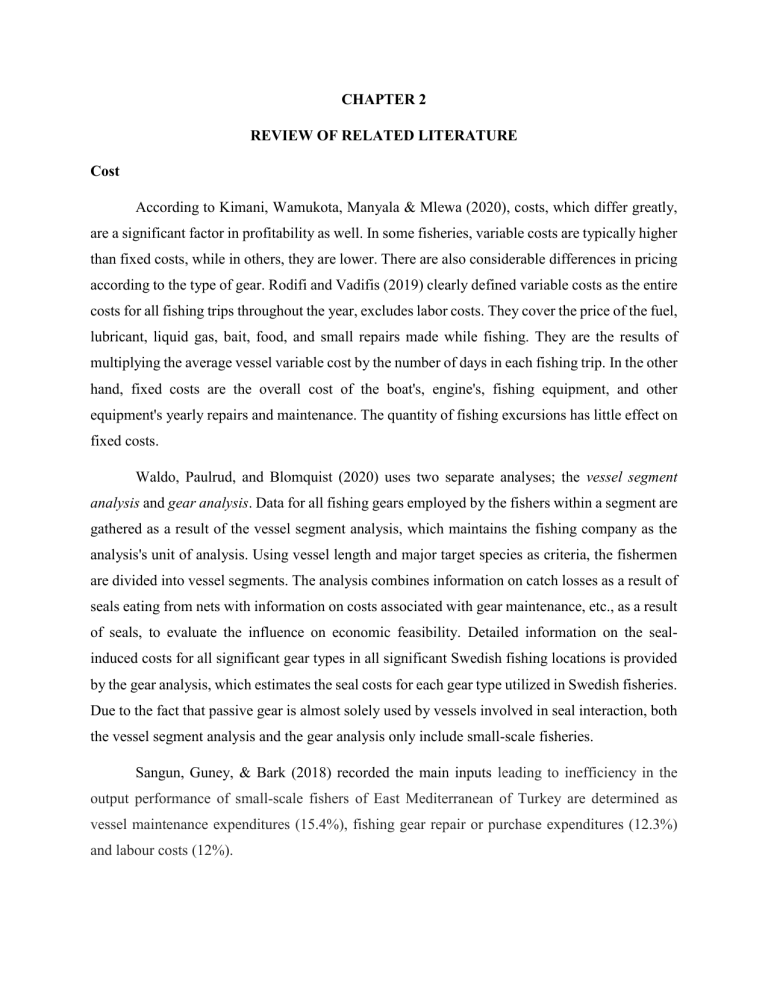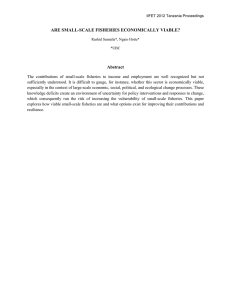
CHAPTER 2 REVIEW OF RELATED LITERATURE Cost According to Kimani, Wamukota, Manyala & Mlewa (2020), costs, which differ greatly, are a significant factor in profitability as well. In some fisheries, variable costs are typically higher than fixed costs, while in others, they are lower. There are also considerable differences in pricing according to the type of gear. Rodifi and Vadifis (2019) clearly defined variable costs as the entire costs for all fishing trips throughout the year, excludes labor costs. They cover the price of the fuel, lubricant, liquid gas, bait, food, and small repairs made while fishing. They are the results of multiplying the average vessel variable cost by the number of days in each fishing trip. In the other hand, fixed costs are the overall cost of the boat's, engine's, fishing equipment, and other equipment's yearly repairs and maintenance. The quantity of fishing excursions has little effect on fixed costs. Waldo, Paulrud, and Blomquist (2020) uses two separate analyses; the vessel segment analysis and gear analysis. Data for all fishing gears employed by the fishers within a segment are gathered as a result of the vessel segment analysis, which maintains the fishing company as the analysis's unit of analysis. Using vessel length and major target species as criteria, the fishermen are divided into vessel segments. The analysis combines information on catch losses as a result of seals eating from nets with information on costs associated with gear maintenance, etc., as a result of seals, to evaluate the influence on economic feasibility. Detailed information on the sealinduced costs for all significant gear types in all significant Swedish fishing locations is provided by the gear analysis, which estimates the seal costs for each gear type utilized in Swedish fisheries. Due to the fact that passive gear is almost solely used by vessels involved in seal interaction, both the vessel segment analysis and the gear analysis only include small-scale fisheries. Sangun, Guney, & Bark (2018) recorded the main inputs leading to inefficiency in the output performance of small-scale fishers of East Mediterranean of Turkey are determined as vessel maintenance expenditures (15.4%), fishing gear repair or purchase expenditures (12.3%) and labour costs (12%). In the report of Food and Agriculture Organization of United Nations (FAO), traditional credit delivery methods have substantial transaction and monitoring costs, especially in rural areas where many SSF are located and which are underserved and unbanked. Digital technology adoption is anticipated to lower these expenses and broaden the accessibility of credit services. The use of digital technology, according to several of the financial institutions' responders, not only increases their own productivity but also makes it easier for their customers to obtain loans. REFERENCES Badiola, J.A.R., Guinto, E.J., Das. P.K., Gietzen, T., Yang. L. and Van Anrooy, R. 2021. Financing small-scale fisheries in the Philippines – A policy brief. Rome. https://doi.org/10.4060/cb8029en Waldo, S., Paulrud, A., & Blomquist, J. (2020). The economic costs of seal presence in Swedish small-scale fisheries. ICES Journal of Marine Science, 77(2), 815-825. Kimani, P., Wamukota, A., Manyala, J. O., & Mlewa, C. M. (2020). Factors influencing financial performance in marine small-scale fisheries value chain in Kenya. Marine Policy, 122, 104218. Roditi, K., & Vafidis, D. (2022). Small-scale fisheries in the south Aegean Sea: métiers and associated economics. Ocean & Coastal Management, 224, 106185. Sangun, L., Guney, O. I. A. N., & Berk, A. (2018). Economic efficiency performance of smallscale fisheries in the East Mediterranean coast of Turkey. New Medit, 17(4), 71-80.





